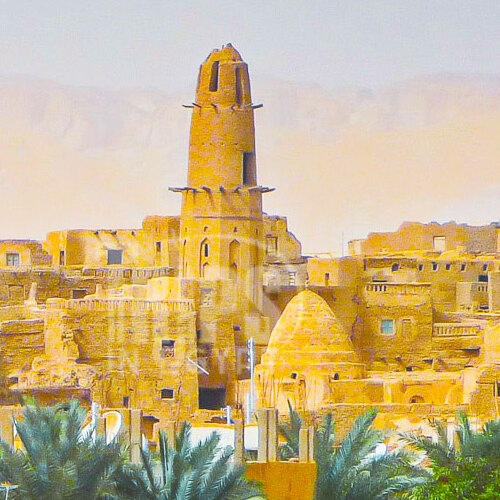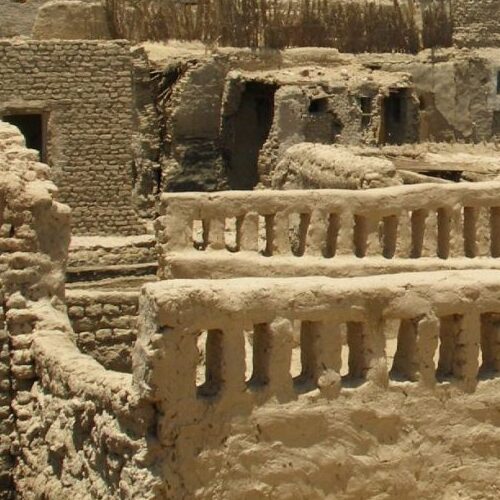No other nation in the world says ‘Welcome’ as often as the Egyptians, and every time, they mean it. While the ancient civilization of Egypt continues to amaze, contemporary Egyptians are equally remarkable.
Deir El-Hagar
Journey to Deir El-Hagar Temple: A Portal to Ancient Egypt
Nestled on the western fringe of the Dakhla Oasis, some 10 kilometers from El-Qasr, lies the remarkable Deir El-Hagar Temple, known as ‘The Monastery of Stone’. Constructed from the warm hues of sandstone, this site, originally named ‘Set-whe’ or ‘The Place of Coming Home’, emerges from the sands of time as a testament to Egypt’s enduring history.
Uncovered by archaeological endeavors after centuries of obscurity beneath sand and rubble, Deir El-Hagar has undergone meticulous restoration. Thanks to the collaborative efforts of the Supreme Council of Antiquities and the Dakhla Oasis Project beginning in the 1990s, this ancient marvel is now accessible to the world.
Regarded as one of the most well-preserved monuments from the Roman era in Dakhla Oasis, the temple, as per Olaf Kaper of the Dakhla Oasis Project, was a center of festivity rather than a cult. Its foundations were laid under Emperor Nero (AD 54-68), and the temple was dedicated to the gods Thoth and Theban Triad, signifying a blend of religious reverence and agricultural advancement. The Romans established it, alongside an irrigation system and farms, to attract and support farmers.
Subsequent emperors left their marks: Vespasian (AD 69-79) enhanced the sanctuary, Titus (AD 79-81) added the porch, and Domitian (AD 81-96) adorned doorways and the grand gateway. Contributions continued until the 3rd century AD, each adding layers of history and artistry.
The temple, spanning 7.3 by 16.2 meters, is encased by a surviving mudbrick wall, with remnants of paintings and plaster hinting at its former glory. Visitors enter primarily through the east, with a lesser-known southern entrance. The temenos wall of the sanctuary is etched with graffiti, a silent narrative of travelers and pilgrims from the 19th century onwards, revealing the height of the sands at that time.
Historically, the temple was first brought to light in January 1874 by Gerhardt Rohlfs’s expedition, which failed to cross the Great Sand Sea and rerouted through Siwa. Their names are etched on a column in the hall, a silent testament to their journey. Later, Remale cleared sand from the sanctuary in the same year, and a comprehensive description by Winlock was published in 1908. Ahmed Fakhry’s excavations in the 1960s further unveiled the porch’s facade.
Inside, mud-brick columns line the path from the gate to the entrance, where once miniature sphinxes stood, now housed in the Kharga Heritage Museum. The entrance, flanked by columns, leads to a room supported by four more columns and then to the hall of offerings, preceding the central sanctuary.
The sanctuary, adorned during Hadrian’s reign (117-138 AD), showcases stunning ceiling paintings of deities Nut and Geb. Notably, the reconstructed zodiac ceiling, unique in its display outside the temple, originally portrayed gods like Osiris as the Orion constellation and Tutu as a sphinx.
The temple’s western wall prominently features Amun-Re and Mut, its principal deities. Other gods depicted include the Theban Triad, Seth, Nephthys, Re-Horakhty, Osiris, Isis, Min-Re, and the Helipolitan gods. Amun Nakht, the Dakhla god, and Nehmetaway, his local associate, also appear, suggesting their local origin.
Surrounding the temple are ruins of half-collapsed Roman buildings, a pigeon house, and agricultural relics, painting a vivid picture of Roman life here. A Roman-era cemetery to the northwest holds terracotta coffins with human forms, further enriching the historical tapestry of Deir El-Hagar.
Today, Deir El-Hagar stands as a gateway to the past, offering visitors a glimpse into the deep, multifaceted history of Egypt’s Western Desert.
Created On March 18, 2020
Updated On Aug , 2024



